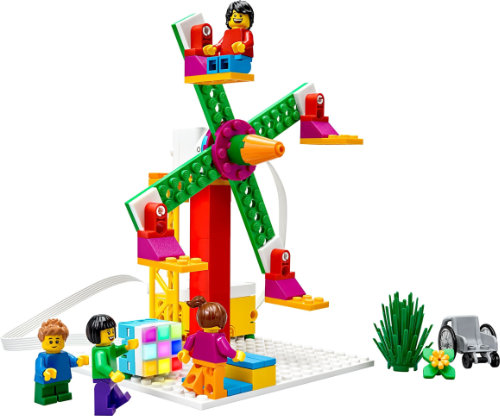LEGO Education Spike Essential vs WeDo
WeDo has a long history in LEGO Education. The first WeDo construction set came out in 2009 and featured a connector or “hub” to connect the motor(s) and sensors in the set to a USB port on a computer. The set was upgraded 7 years later, in 2016 and this time it came with an intelligent hub that used Bluetooth to connect to a computer or smart device.

WeDo (2009)

WeDo 2.0 (2016)
However, the essence of the set remained the same: a single motor, a tilt and a distance sensor and an assortment of mostly System bricks (bricks with studs) with a few Technic elements most of which also had studs. This is important because building with System elements is different to building with modern Technic elements in two ways.
- building with System elements usually happens from the bottom up (you stack one element on top of the other) whereas building with Technic elements usually happens from the core to the outside. This building style is more complex to grasp and less suited for younger learners.
- connecting a System element to another System element requires less dexterity and force than connecting Technic elements. Again, an important consideration when it comes to younger learners.
LEGO Education sets tend to have a longer life-span that retail sets, but there there was a general expectation that a WeDo 3 set was in the offing. After all, why change an otherwise successful formula. Rather than keeping the name, the new set is called Spike Essential and follows in the footsteps of the earlier Spike Prime set that came to replace LEGO Education MINDSTORMS EV3.

Spike Essential
Aside from the name, there are some fundamental changes in the Spike Essential set:
- The hub can no longer be powered by standard AA batteries. In a sense this is good: fewer batteries less waste, unless you use rechargeable AA batteries which, in the WeDo set, will last a long time. Of course this also increases the price of the set.
- Rather than including a single motor, the Spike Essential set comes with 2 motors. The WeDo motors were simple on/off devices but these motors also have an internal sensor allowing for precise movement.
- There is a single sensor in the set: a light/color sensor. This means losing the distance sensor (compared to the WeDo set) but the extra capabilities of this sensor allow for a lot of different applications
- There is also a color light matrix. This device has the same form factor as the color sensor and has 9 RGB LEDs that can be individually programmed to emit one of 9 preprogrammed colors

Spike Essential electronics
This is where things get tricky:
- The Spike Essential set contains 4 minifigs and lots of other elements that create storytelling opportunities (a wheelchair, a wand, a dog, etc.) The Spike Essential set clearly is a winner on this front.
- There are no gears in the Spike Essential set (!!). This requires some further explanation. The WeDo set contained a simple on/off motor and many of the constructions relied on mechanical solutions with minimal programming needs beyond turning motors on and off. The Spike Essential set has 2 intelligent motors, allowing students to program relatively precise movements. As a result, the WeDo models contained in the app were quite complex and beautiful. The Spike Essential models are a lot clunkier and simpler. Aesthetically the WeDo models are a lot more pleasing, but in terms of robotics, the Spike Essential models allow for more precise control and programming skill development.
- The way lessons are presented has also changed. WeDo 2.0 relied on presenting a mechanical core and letting the students reverse engineer a model from images. After that a simple program was proposed and it was up to the students (or the initiative of the teacher) to make it more interesting or complex. In Spike Essential, the models are simpler and require a different type of problem solving. Many of the models require “repairs” in order to work and they are aimed at getting the student to understand the model and make it their own. Rather than models, each activity is a story in which the robotic element plays a role, but story telling is equally important.

WeDo 2.0 Dino

WeDo 2.0 pollination

Spike Essential Ferris wheel

Spike Essential crocodile?
So, is Spike Essential “better” than WeDo 2.0?
It depends on what you are looking for. The elements (and also the color scheme) in WeDo has resulted in a plethora of beautiful fan models (developed by teachers) that student can recreate in class. Spike Essential hasn’t been around long enough to elicit quite the same response, but the few models that have been developed by teachers (outside those in the software) are quite a bit clunkier. Is that bad? Again, it depends. Imagine yourself in the shoes of a 6 or 7-year-old who is presented with a beautiful WeDo model. Building it may be fun, playing with it hopefully entertaining. Building something remotely similar using their imagination is an almost impossible task.
Now look at Spike Essential again. The models are simpler, but students are taught to make them their own from the very start. Making something equally simple and functional is suddenly a lot more realistically achievable.
There is another factor I haven’t mentioned so far: price. WeDo 2.0 initially retailed around 150€, but about a year before Spike Essential came out that price was suddenly increased to 190€. Spike Essential on the other hand has a RRP of 300€, double the original price of WeDo 2.0. This means that the initial investment required to get started has increased significantly. Whether or not you feel you really get more bang for your bucks is of course a very personal opinion.
Last, but not least, I would like to mention the software. Spike Essential is included in the Spike software that also serves for Spike Prime. This has obvious advantages in terms of software management for teachers and allows for a more natural progression from one platform to the next. Also of note is the fact that this software can be used both on tablets and on computers. Since WeDo 2.0 was tablet-only, this is a significant improvement in terms of the available options.

Spike Essential software
Of course the true test for any platform is time. I look forward to working with Spike Essential and transitioning to Spike Prime when my students are ready. I believe my younger students will be able to do much more advanced things on a programming level, but on a mechanical and even an aesthetic level I will really miss WeDo.
We wish to thank LEGO for providing this set. Our opinions are just that… our opinions
33544